Archive for ‘Philosophical’ Category
Unpacking: Paper Doll Explores a Video Game About Organizing
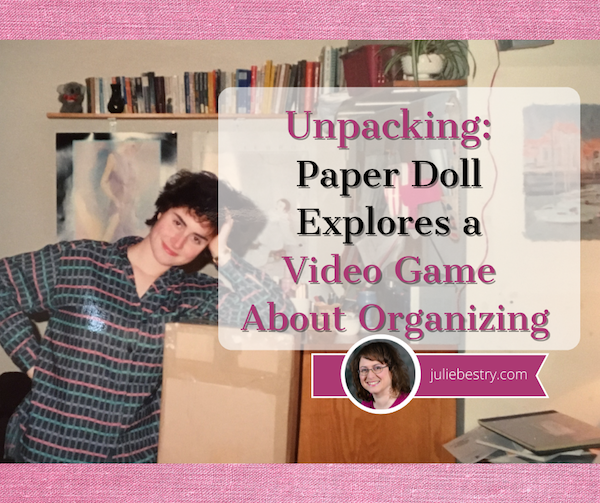
[Editor’s Note: This is not a typical Paper Doll post, but it is about organizing, so don’t worry that I’ve changed the focus of the blog. Also, if you click on any of the links in the first few paragraphs and get distracted playing classic games in your browser, don’t forget to come back and read the rest of the post!]
UNPACKING

I have limited experience with video games. Which is to say, I played the tennis-like Pong at a friend’s house when it first came out around 1972 and delighted in PacMan (and Ms. Pacman) while waiting for my Pizza Hut meal to be served, during my adolescent years.
And I even plunked myself down to play Super Mario Bros. when I was in graduate school and needed something obsessive and concentration-focusing to take my mind off what the heck I was going to do with my life when graduate school was over.
But game strategy, manual dexterity, competitiveness, and the ability to bonk a cartoon plumber’s head upward onto a brick to make a mushroom appear (if I’m recalling correctly) — none of these have ever been my strong suits.
In the past three decades, my interaction with video games has been limited to helping my clients pare down their video game collections, organize what they keep, and sell or donate the remainder. I haven’t played, or had any desire to play, any games until last week, when Australian game developer Witch Beam released Unpacking. My Google News feed knows me too well, and upon last week’s release, I was inundated with articles and reviews about this intriguing game.
The company describes Unpacking as a “Zen puzzle about unpacking a life.”
The game has eight chapters or levels, each corresponding to a move to a new “home” — a childhood room, a college dorm, one’s own apartment, sharing a space with a significant other, etc. — all for an unnamed, unknown protagonist. It starts in 1997 and continues forward to today. As players, we are never explicitly told the story of this character, but through her possessions, a certain intimate bond is formed.
The game has been described as “part item Tetris, part home decoration.” You select digital cardboard boxes, open them, and through the game, put the items away. There are pre-ordained slots or shelves; the game is designed as a puzzle, and the goal isn’t to throw everything higgledy-piggledy but find the logical home.
To move to the next level, you need to generally put things where a reasonable person might think they should go. That said, as part of the accessibility features of the game, you can apply the “allow items anywhere” option to eliminate the puzzle element. With this choice, you can’t really put an item in the “wrong” place any more than you could in your own home. (Still, please don’t store extra pantry items or clothes in the bathtub; we professional organizers have seen that in the real world, and it’s just not a great option.)
So, just like at your house, you can put things in weird places. And while I haven’t seen a treadmill or Peleton in the game, I’m betting that just like in real life, you can hang your clothes on exercise equipment. As a player, you get to decide where things belong, but you have to obey the laws of physics and geometry. You can’t fit square pegs in round holes or ten pounds of whatever into a five-pound bag.
I find it appealing that there’s no competition and no timers counting down. But there are, apparently, 14,000 different audio sounds to go along with tucking items in nooks and crannies, setting a toothbrush in a water glass, arranging books on shelves and supplies in drawers, and so on. If you lift a T-shirt to a hanger placed on a rod, the shirt hangs; move it lower to a stack of shirts, and it self-folds. (If only actual unpacking, organizing, and indeed, laundry day, were so magical.)
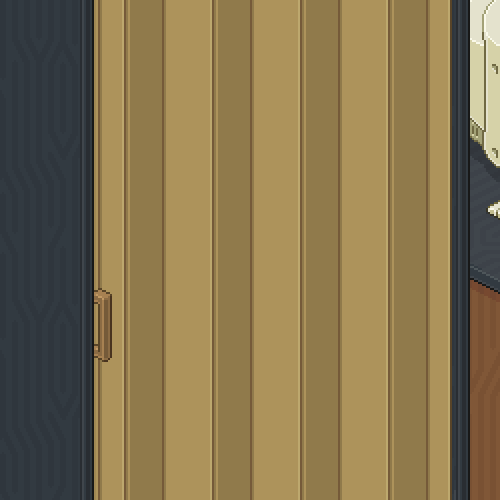
In addition to putting things away (that is, giving them homes), you can change the color signature of the room, add some on-screen stickers to decorate, take photos of a completed room, and add those photos to a scrapbook, complete with a “handwritten” description of your move-in experience.
Here’s a peek at the game’s launch trailer:
Throughout it all, there’s a soundtrack from a BAFTA (British Academy of Film and Television Arts) award-winning composer, Jeff van Dyck. If video game soundtracks are your thing (Yes, I’m looking at you, my friend Chris!), you can listen to Unpacking’s soundtrack on Spotify and purchase it in all the usual music-buying places like Amazon, Apple Music, Bandcamp, etc. (And no, Chris, I’m not listening to this in the car on any road trips.)
Warning: I should also note that, assuming you’re reading in North America, there will be some oddities in the rooms and homes in Unpacking. The refrigerators are not the full-sized ones we have, but those smaller, under-counter ones that are barely bigger than dorm fridges. The bathtubs have the glass half-walls I saw in Europe; I’ve yet to figure out how one manages not to soak the half the bathroom, but at least there’s no need to run any water in the actual game.
I’ve seen reviews calling the game calming and endearing, but also cathartic and moving. (Of which, I have more thoughts, below.) As a professional organizer, of course, I found this tweet hopeful:
Y’all, I already knew @UnpackingALife is a great game, but my daughter is cleaning her room and I was impressed with how much better it looks than normal.
She told me “Unpacking really helped.” Holy crap ? Best game ever!!!! pic.twitter.com/WQNhT3fHd7
— Dr. Ashley Godbold ????? (@ashleygodbold) November 6, 2021
And for those who wonder how much detail is available to organize exactly how and where you want things to be, this tweet gives you a sign:
We definitely didn’t expect this kind of creativity from our replay feature, but we love it so much! ??
Credits: @carellogyhttps://t.co/wZe1SQpICc pic.twitter.com/115WshTfLj
— Unpacking ? Out NOW! (@UnpackingALife) November 7, 2021
Unpacking is available for a variety of platforms, including Windows, Mac, Linux, Nintendo Switch, and Xbox One and runs $19.99.
ACCESSIBILITY
In the real world, unpacking and organizing a new home, whether a dorm room, a studio apartment, or a multi-bedroom family house, can be a massive headache. Imagine how much more difficult is must be for those with physical disabilities or distracting cognitive challenges (ranging from ADHD to traumatic brain injury). This is just one reason why many clients call in NAPO or NASMM professional organizers who specialize in relocations to work some video game-like magic in setting up a new space.
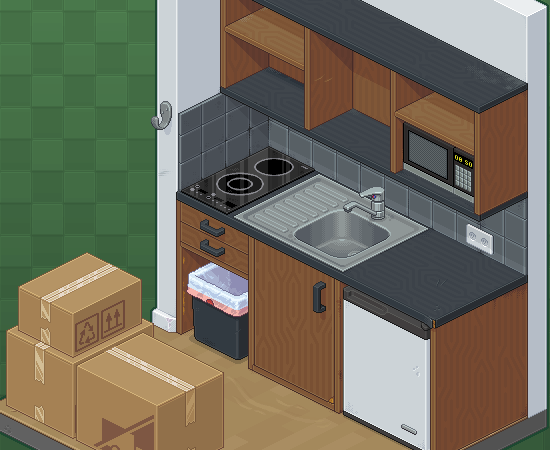
I can’t be the only person who gets flashbacks to Bewitched watching this sped-up kitchen unpacking/organizing scene play out. Seriously, compare it to Samantha Stevens working her tinka-tinka-tink:
There are no in-game professional organizers, but Unpacking‘s developers prides themselves on its accessibility features.
For those needing visual assistance, the user interface buttons can be enlarged, and you can zoom in on the screen; if you’ve made a booboo, the red “invalid” outline (remember what I said about the laws of physics?) can be changed to a different color. And you can disable the animation feature for room-swapping (in case you unpack a box of kitchen items when you’re in the living room) to avoid motion sickness.
In terms of audio assistance, the game lets you operate soundtrack music and sound effect volumes separately, and there are no audio-exclusive cues for game play, so players who can’t hear don’t miss any of the essential game features.
For cognitive accessibility, the game has no penalties; there’s minimal text, and reading skills (in English or otherwise) are not required in order to play. And, as mentioned, you can turn off the puzzle angle to be allowed to put things anywhere.
There are also a variety of mobility-related accessibility features. None of the actions require pressing more than one button at a time, clicking-and-dragging, holding down buttons. Computer versions support playing via a mouse and keyboard, a game pad, or touch (“on supported hardware,” they note) and you can play one-handed with just a mouse. The Nintendo Switch version of the game supports (and I quote, because I have no idea what this means), “gamepad, touch, and gyro in two-handed and one-handed configurations.” Controls are re-mappable when necessary to support a user’s accessibility needs.
While Paper Doll is neither a gamer nor a reviewer, I think it’s important to accent accessibility features in products, and while this does not arise often when I talk about notebooks and storage options, I intend to be more cognizant of such issues in future posts.
UNPACKING THOUGHTS ABOUT UNPACKING
Having missed three decades of video game development, I am, at best, only peripherally aware that not all games are multi-player shoot-em-ups and car-racing (and crashing) extravaganzas. Certainly I knew about The Sims, a series of simulation games where players create virtual people, build them homes (and families) and play with their careers, activities, and moods and desires.
Apparently, this approach is called a sandbox game, an open-ended type of video game where players have a freedom of movement for their creations and there are no pre-set goals. (If only we humans felt that much ease in creating our lives and risking change!) The popular Minecraft, with it’s blocky 3D people and infinitely expanding world of raw materials, tools, and create-able structures is similar.
Unpacking feels like it belongs in a world tangential to these sandbox games; there’s freedom of movement, no timers or competition, and you can’t lose your character’s life by unpacking things in the wrong order or organizing things “wrong.” But like real life, there is a very solid goal for you as the in-world character: unpack in an organized way to live your life.
In Vice‘s Unpacking Is a Lovely Game About the Power of Seemingly Mundane Objects, Moises Taveras has created a great introduction to the game beyond the broad strokes. Through it I learned some spoilers and realized that there was more depth of insight to be had beyond how many frying pans could be fit into a cabinet:
The “challenge,” a term I’ll throw around incredibly loosely, becomes finding where everything fits best. It’s a logic puzzle, so as long as you’ve been in a kitchen, a bedroom or bathroom, you’ll be able to sufficiently reproduce a functional home. … There’s a joy in getting it all right, but the greater one to me was playing a game that, in bits and pieces, understood the relationship we build with the things we collect.
But there’s more. After I learned of Unpacking, I started reading every review I could find, and what’s particularly gripping about the game is how you get to see the protagonist’s life unfold through her possessions (and those with whom she shares her space). It reminded me of Sam Gosling‘s book, Snoop: What Your Stuff Says About You.
6 Steps to Ease Your Way Into Organizing the New Year
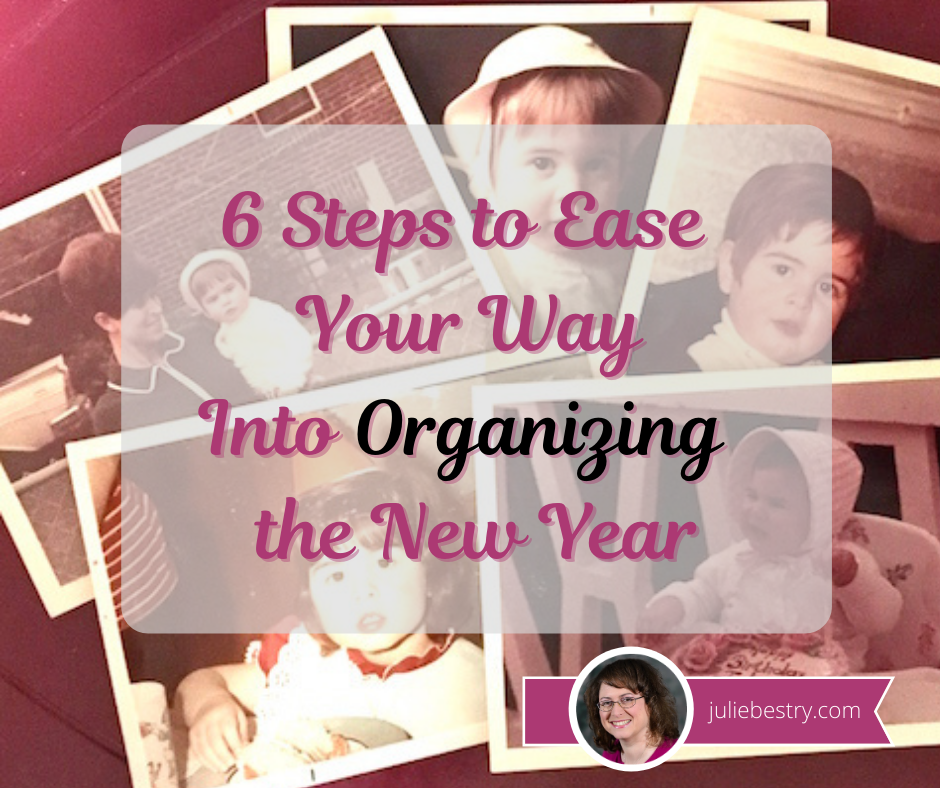
Happy New Year! Paper Doll knows that the first week of any new year (let alone after the year we’ve just escaped), can be daunting. Instead of weighing you down with homework, how about we set you up for success with some simple strategies that will ease you into a more organized approach to this year? Deal?
START WITH BABY STEPS
When it comes to clutter, it’s not the space it takes up in your house, it’s the dent it puts in your life!
When it comes to clutter, it's not the space it takes up in your house, it's the dent it puts in your life! Click To TweetIf you’re late every day because you can’t find your keys or your kids can’t find their homework, that’s a much bigger deal than a cluttered guest room closet or piles of old birthday party photos that haven’t been scrapbooked. (Need I explain to younger readers that photos used to be on paper?)

Focus on your biggest daily stressors, break them down into small, actionable steps, and solve those first.
For example, each night after dinner, sort through and declutter one kitchen drawer. When you change for bed, flip through five hangers to see what’s ready to depart. Put a table near the door for the daily launch pad of essential items you need to take with you. Hang a key hook and charging station there and make it a nighttime ritual with your kids to check that everything you’ll need the next day is there.
Don’t even know where to start? Try some of these easy options to organize your finances, your health, and your life – no heavy lifting required:
- Make a tax prep folder. Just grab a folder, label it Tax Prep 2020, and as documents start trickling in this month, you’ll at least have some place to stow them. (Don’t know what to watch for? Read last year’s Paper Doll Says the Tax Man Cometh: Organize Your Tax Forms to get a head start.)
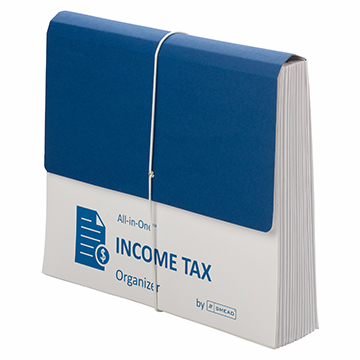
If you want to get a little more advanced, consider Smead’s All-in-One Income Tax Organizer.
- Flip through your new 2021 planner or your digital calendar to see what medical appointments are already scheduled. Make a list of all the doctor’s appointments that you need — family doctor/GP, pediatrician, dentist and orthodontist, ophthalmologist and/or optometrist, OB/GYN, and any specialists, as appropriate.
Check all those appointment cards at the bottom of your bag or thrown in the junk drawer to make sure you’ve scheduled them on your calendar. Then pick up the phone and make all the other appointments now. (Going forward, always schedule your next appointment before you leave their offices. See if you can make one day a week, like Mondays, your “appointment” day so that you’ll get it out of the way early in any week.
- Look through your wallet and VIP files to see what needs to be renewed — driver’s license, car registration, passport, etc. Instead of marking just the expiration date, make notations on your calendar to handle renewals enough in advance so nothing falls through the cracks.
GIVE UP TOLERATING WHAT BRINGS YOU DOWN
Last summer, in Organize Away Frustration: Practice the Only Good Kind of Intolerance, we talked about this at length. Take notice of the things that annoy you, whether it’s a closet too cluttered that you can’t close the door, a light fixture that keeps flickering, or a cable bill that should be renegotiated with a gentle threat to cut the cord. If something doesn’t bring you closer to the life you want to be living, make this the year you let it go. Don’t tolerate what doesn’t delight you.
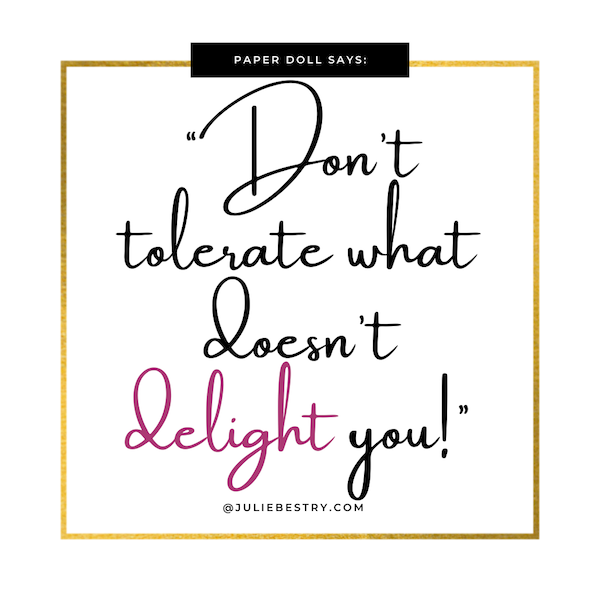
Do a brain dump. Think of a brain dump as mental hygiene, like the cognitive equivalent of brushing your teeth. Ever have the taste of garlic or fish in your mouth after dinner, such that you couldn’t really enjoy your dessert? A brain dump, where you get everything out of your head and onto paper, let’s you stop thinking of things and start thinking about them, in context. Taste your life!
Try to make a list of everything that you know you have to do in order to stop being frustrated. Go room to room and write down what you need to address. (If you’re the kind of person who really needs categories, you can create columns for things that are free or only require your own effort vs. things that require payment.)
Once you have the list, you can start working through what are immediate priorities, what’s worth scheduling, and what can go on the “I’ll do it if I’m so bored it’s between doing this task or watching paint try” list.
Feel free to tackle the tasks in any order you choose, but come up with a plan. Easiest-to-hardest helps you gain confidence; hardest-to-easiest makes everything less stressful because you’ve tackled the most difficult item first. Doing the free tasks first gives you time to budget for the more costly ones, but if you can purchase freedom from a frustration, it’ll release mental energy for other tasks.
STOP USING CLUTTER AS A TO-DO LIST
- Are you keeping a holiday gift on the dining table so you’ll remember to write a thank you note?
- Do you have boxes of donations in the middle of the hall to prompt you deliver them?
- Are you keeping a receipt to remind you to get someone to pay you back for their half of a gift (or to remind yourself to pay them back)?
- Is your unopened electric bill sitting out to remind you to pay it?
- Do you have months’ old email in your inbox hoping that keeping it there will push you to reply?
How’s that working for you? Instead, follow these steps.
- Clear your desk or a space at your kitchen or dining room table to give yourself work space.
- Take five minutes and look around the room you’re in. What do you see that’s out of place because you’re (intentionally or otherwise) using it to prompt you to do something?
- Grab a notebook and for each thing that’s in the wrong place, write down what you should be doing, instead. Yes, this gives you a To Do list that will stare you in the face (but we’ll get to that).
- Put the item away so that it’s no longer clutter.
- DO THE THING!
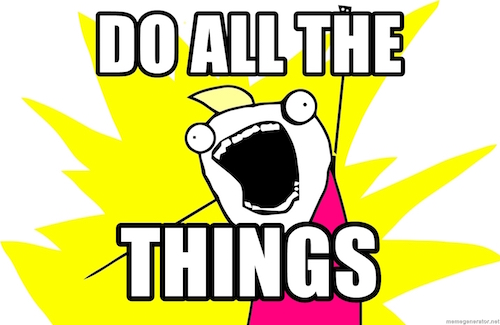
©2010 Allie Brosh, Hyperbole and a Half, via MemeGenerator
Let’s see how this works. Unpack and put away the holiday gift and go grab a notecard, envelope, return address label and stamp. Put it down on your cleared desk space.
Now, here’s the first tricky part. You can either write out the thank you note right now (check out my Gratitude, Mr. Rogers, and How To Organize A Thank You Note for guidance) and then you won’t use all your mental energy procrastinating about it, or you can put it on your To Do list. If you write the note now, you can put it on your To Do list and check it off your list, all at once, giving you an immediate sense of accomplishment! Whoohoo!
Repeat the process. Carry the donation boxes to your car, then eyeball your calendar to figure out when you can deliver the donations. Schedule the task, delegate it to a family member, or use GiveBackBox to schedule a free pickup.
And again! Use your favorite app, like Zelle, CashApp, Paypal (or ugh, fine, Venmo) to pay or request money and either file or shred the receipt as necessary. Pay the electric bill. Reply to the email or declare bankruptcy on it.
FOLLOW THE ICE CREAM RULE
So maybe your clutter is there because you don’t know where else to put it.
I tell my clients, “Don’t put things down, put them away.” By “away,” we assume you’ve already got a location in mind. Good organizing systems have two parts: the where & the how. If you bring home a bag with three items, ice cream, toilet paper, and breakfast cereal, I’m pretty sure you’re going to put the ice cream away in the freezer first (and immediately) to keep from having a melted, sticky mess. The freezer is the “where” but putting the ice cream away first is the “how.” It’s so innate, you don’t even think about.
Clutter comes from deferring that decision making. With ice cream, you don’t even have to stop and think; it’s instinct built from life-long experience. With everything else entering your home (whether a purchase, a gift, or a freebie), decide on a home before you buy or bring it in. Once it’s in your space, build time into your calendar for how/when you’ll deal with maintaining it or getting it back to where it lives.
Do you bristle at the idea of planning when you’ll do things? Maybe you feel like scheduling things belongs in the category of “budgets” and “diets” — it’s about The Man trying to keep you down!
The thing is, if you’re organized, you probably already have a system and your system feels like a safety net rather than a suffocating obligation. If you’re NOT organized, you’ll just have to trust that a system – a plan, if you will – makes life more organized so you don’t have to keep thinking about these things.
What are the triggers in your system? When will you do laundry: when the laundry basket is full or when it’s Tuesday morning after breakfast? When will you file financial papers? When your in-box is overflowing, or when your computer dings to tell you it’s 11:45a on Wednesday?
Remember: “Someday” is not a day on the calendar. Until something is innate, having an auditory or visual trigger (or both) will help remind you where and when to put things away.
REMEMBER THAT EVERYTHING SHOULD HAVE A HOME…BUT NOT EVERYTHING HAS TO LIVE WITH YOU
Systems are important, but don’t forget a universal truth: not everything you own needs to stay in your orbit forever.
Give what is no longer age-, size-, or lifestyle-appropriate new life via charity or consignment. Let it be a blessing to someone else.
Give what is no longer age-, size-, or lifestyle-appropriate new life via charity or consignment. Let it be a blessing to someone else. Click To TweetIf it’s broken and you’re not willing to spend the time or money to repair it, let it go. If you have an emotional attachment to something that’s broken, outdated, or takes up too much space to keep, take a photo of you holding it or wearing it. Then set it free!
Setting up a donation station in your home is as easy as putting a box or plastic tub in your utility room, mudroom, or garage. When you’re doing laundry or sorting through toys in the playroom, if it doesn’t fit your life, take it to the donation box right away. When the box is full, log the contents (if you’ll be taking a deduction), and send it to your favorite non-profit. Don’t wait until you have lots of boxes – one box of useful items or clothes, sent on its way, is more useful to others than mountains of boxes that never make it out of your home.
Are your file folders bulging? Do I Have To Keep This Piece of Paper? gives you a clear idea of what you need to keep and for how long. The rest? Shred and send on its way! Buh-bye!
FOLLOW THE BUDDY SYSTEM
Getting your space, time, and priorities in order can be overwhelming, but you don’t have to go it alone. For accountability and support in reaching your organizing goals, buddy up with:
- Your spouse – Trade the chore you hate (unloading the dishwasher) for the one that annoys your spouse (folding laundry) and you’re each less likely to procrastinate.
- Your kids – Make organizing a game – play Beat the Clock with your kids to see who can collect the most things that don’t belong in the living room before the song ends, and then work together to put the items away.
- Friends – Make organizing social, even when you can’t get together. Text “fashion show” photos or do a Zoom call as you organize your closets. (Friend-of-the-blog Nancy Haworth of OnTask Organizing and I did this last week! I got rid of big-shoulder-pad 80s-style blazers and she jettisoned clothes that pre-dated her strong, lithe, “certified exercise instructor” shoulders!)
- A professional organizer – As a Certified Professional Organizer®, I know how much my clients get out of having someone who knows the ropes guide them in making solid decisions and developing systems to surmount those challenging obstacles. Find a professional organizer near you by using the search function for the National Association of Productivity and Organizing Professionals (NAPO).

Speaking of which, it’s January, so that means it’s GO (Get Organized and Be Productive) Month! It’s the perfect time to focus on making your life run the way you want it to. Happy New Year, Happy GO Month, and just plain…be happy!
NAPO2018: Advancing at a Retreat

As I write this post, I’m counting down the hours until I head to suburban Chicago for NAPO 2018. From 2002 through 2017, I had the pleasure of attending my industry’s NAPO Conference and Expo each year. 2018, however, has brought quite a few new developments.
First, we’ve changed our name! We’re still NAPO, but our full name has changed from the National Association of Professional Organizers to the National Association of Productivity and Organizing Professionals. While personal and professional productivity (say that three times quickly!) has always been a huge part of the organizing process, it’s taken many decades to give that side of what we do the name-value attention it deserves.
Second, we’re learning not to hide our light under a bushel (because piling things atop other things just leads to clutter). Instead, we’ve been spreading the word about organizing far and wide. For example, you may have seen our current president (and my NAPO 2015 conference roommate) Ellen Rubin Delap and some of our colleagues on CBS Sunday Morning this past weekend, talking about why people are so greatly in need of organizing assistance and what we can do to help.
I’ve been trying to spread the word, too, such as with my guest post for the NAPO Get Organized blog, entitled In Checkbooks and Underwear Drawers: What Certified Professional Organizers Offer Our Clients. The goal was to make sure that everyone (the public, the media, aspiring professional organizers, veterans, etc.) understands why we professional organizers (including CPOs, like me) do what we do: for you, the client. We recognize the vulnerability you share when inviting us into your homes and offices, and we want to honor you with respect.
Third, at least for this year, our conference structure is changing. There’s no expo. That means that Paper Doll won’t be frantically running around the expo floor in order to learn about every new product on display. (Never worry, readers. This just means that I’ll be spending more time independently investigating the great organizing products on the horizon. If your company makes something novel in support of organizing or productivity, be sure to use the contact page to let me know about it!)
I should note while there is no formal expo, two of our beloved NAPO business partners will be in attendance as conference sponsors. So, I’m looking forward to seeing our friends at Smead, the source of so many past post-conference product reviews, and Brother, from whom I just bought my new laser printer for Paper Doll HQ, and from whom I’m hoping to learn more about the Cube, their Bluetooth-connected label printer.
Fourth, and finally, this year’s conference is envisioned as a retreat, with more focus on self-care, not just so that we professional organizers can balance our lives, but so that we can better help our clients achieve balance.
Sure, we’ve got our traditional educational workshops on ADHD, space planning, chronic disorganization, Quickbooks efficiency, and the myths surrounding multitasking. But this year’s conference has a real focus on the robust emotional side of what we do and what our clients need, with topics ranging from silencing self-doubt and creating better boundaries, to improving self-care (with a focus on better sleep), to Buddhist principles and “Yogic tools” for organizers needs. Gracious!
A retreat brings to mind a spa-like experience, and in addition to our classroom experiences, we’ll have opportunities to participate in yoga, learn belly dancing, and embrace mindfulness. I also always like the duality of the term “retreat” — it’s about taking a step back from the busy hum of everyday life, but it’s also a possibility to advance — advance my knowledge, my skills, and my ability to help readers and clients.
It doesn’t hurt that the conference/retreat is being held at the Q Center in St. Charles, Illinois. Not too shabby, eh?

I look forward to reporting to you on this year’s conference retreat. Until then, feel free to type “NAPO” or “expo” in the search box on the left side of my site to revel in the products and experiences of past NAPO conferences.
Paper Doll’s 6 Organizing Secrets to Kick-Start Your 2018
We’re a few days into the new year, and people are still buzzing about resolutions (Paper Doll doesn’t make them) and theme words or mantras (mine for 2018 is LAUNCH). Americans’ top New Year’s resolutions always include losing weight, straightening out finances, and breaking bad habits, but according to market research, 80% of resolutions are broken by the second week of January. It doesn’t have to be that way.
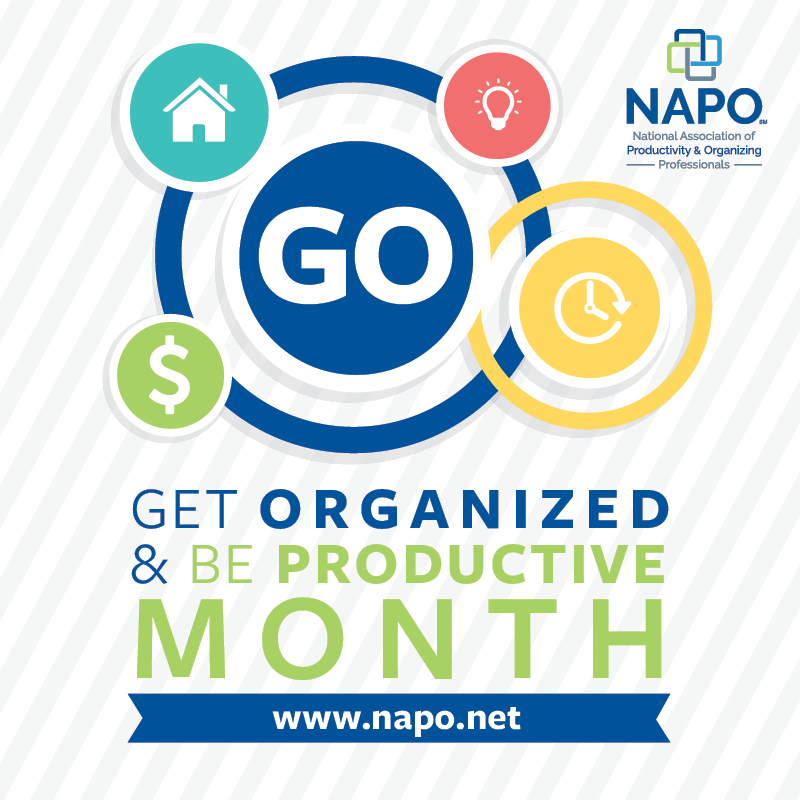
January is National Get Organized Month, and I was on my local NBC affiliate’s morning lifestyle program today, sharing my organizing philosophy and providing tips on how you can kick start your resolution to get organized this year. The conversation was free-flowing, covering some specifics of organizing, but also delving into the personal. For example, Julie Edwards, the host of 3 Plus You, asked me whether you can “make” your children become organized adults. I said that I believe that like anything else, the best way to help your children is to teach useful skills and model good behavior.
WRCBtv.com | Chattanooga News, Weather & Sports
When I was asked about how to deal with different personal organizing styles, I pointed out that within families (and with co-workers), the key is to maintain good communication, and understand that just because someone’s organizing approach is different from yours, it’s not “wrong.” It just may not be right for you.
Here are some tips I think will help you get a running start to achieving your organizing goals in 2018.
1) FOLLOW THE ICE CREAM RULE
I tell my clients, “Don’t put things down, put them away.” The word “away” presupposes you’ve already got a location in mind. But good organizing systems have two parts: the where & the how. When you bring groceries home, you put the ice cream away in the freezer immediately to keep from having a melted, sticky mess. It’s very rare for someone to put away the toilet paper or breakfast cereal before the frozen foods. The freezer is the “where” but putting the ice cream away first is the “how.” It’s so innate, you don’t even think about.
Clutter comes from deferred decision making. With ice cream, you don’t even have to stop and think; it’s instinct. With everything else in your life, when you go shopping (or even when offered things for free), decide on a home before you buy or bring it in. Once it’s in your space, build fixed time into your calendar for how/when you’ll deal with maintaining it or getting it back to where it lives. (When will you do laundry? When will you file financial papers? What will be your trigger — when the laundry basket or in-box is full, or will you put it on your calendar?)
Remember: “Someday” is not a day on the calendar.
2) EVERYTHING SHOULD HAVE A HOME…BUT NOT EVERYTHING HAS TO LIVE WITH YOU
I say this to every prospective client. The eople calling me are focused on the idea of creating systems and order, but don’t always recognize the larger truth, that not everything you own needs to stay in your orbit forever. If it’s broken and you’re not willing to spend the time or money to repair it, let it go. If you have an emotional attachment to something that’s broken, outdated, or takes up too much space to keep, take a photo of you holding it or wearing it. Then set it free!
Give what is no longer age, size, or lifestyle-appropriate new life via charity or consignment. Let it be a blessing to someone else. Setting up a donation station in your home is as easy as putting a box or plastic tub in your utility room, mudroom, or garage. When you’re doing laundry or sorting through toys in the playroom, if it doesn’t fit your life, take it to the donation box right away. When the box is full, log the contents (if you’ll be taking a deduction), and deliver it to your favorite non-profit. Don’t wait until you have lots of boxes – one box of useful items or clothes, sent on its way, is more useful to others than mountains of boxes that never make it out of your home.
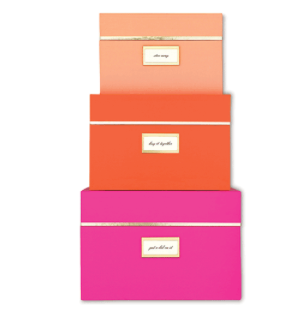
3) DON’T FIGHT CLUTTER WITH MORE CLUTTER
I love The Container Store as much as the next professional organizer. But buying oodles of storage containers – bins, boxes, tubs, and shelves – can only help you organize if you pare down to what you need and want.
Think of it this way: when you see a great outfit at the store, it’s not realistic to say, “Hey, I’ll buy this now and then lose 30 pounds to fit into it.” Even if you do declutter the personal poundage, you never know from where, exactly, that weight will disappear, so shouldn’t buy the new outfit hoping you’ll lose weight in the right places to fit into it.
I’m not saying not to acquire storage containers, but don’t do it first. Once you pare down, pick colorful, fun containers that suit your needs, space, and tastes.
4) TAKE BABY STEPS & DECLARE SMALL VICTORIES
When it comes to clutter, it’s not the space it takes up in your house, it’s the dent it puts in your life! If you’re late every day because you can’t find your keys and your kids can’t find their homework, it’s a much bigger deal than a cluttered guest room closet or drawers of old birthday party pictures that haven’t been scrapbooked.
Focus on your biggest daily stressors, break them down into small, actionable steps, and solve those first. You don’t need to do it all at once, but if you develop a habit of doing a little bit at a time, once your space is straightened up, maintenance will feel natural.
Go through just 5 hangers or one drawer each night. Clear a counter for the daily launch pad of essential items to get out the door. Hang a key hook by the front door and make it a nighttime ritual with your kids to check everything is there that you’ll all need the next day.
5) DECLARE BANKRUPTCY ON CLUTTER DEBT & STOP FEELING GUILTY!
Give yourself permission to declare bankruptcy on the “debt” of unworn clothes three sizes too small or catching up on reading months of magazines. Holding onto something just because you spent money on it or because it was a gift doesn’t make it any more valuable or useful; it just ends of costing you time (dusting or caring for it), space (that you could use for more important things), or money (spent on dry-cleaning or storage rental).
If you’re overwhelmed with thousands (or tens of thousands) or unread emails, magazines, catalogs, junk mail, or check out the classic Paper Doll post, A Different Kind of Bankruptcy, to give you some step-by-step action items.
Don’t feel guilty! Remember, supermodels on those magazine covers are airbrushed and Photoshopped. They don’t really look like that. The same is true with the rooms you see in home and garden magazines. Nobody actually lives in spaces like that – those rooms were specially designed and curated to look “perfect.” No dual-career families with toddler toys and pre-teen soccer team sleepovers live in those magazine homes. Cut yourself some slack.
6) FOLLOW THE BUDDY SYSTEM
Getting your space, time, and priorities in order can be overwhelming, but you don’t have to go it alone. Weight Watchers and 12-step programs succeed because they give people accountability and support. To help you reach your organizing goals, buddy up with:
- Your spouse – Trade tasks you don’t particularly love (like laundry for balancing the checkbook) and you’re less likely to procrastinate on doing what you enjoy.
- Your kids – Children love to “catch” adults breaking the rules and best them at competitions. Make organizing a game – play Beat the Clock to see who can collect the most things that don’t belong in the living room before the song ends, and then work together to put the items away. Make a rule that anything found on the wrong level of the house goes in a basket by the stairs, and everyone must take something (one item for little ones; the whole basket for grownups), and let everyone have a chance to “blow the whistle” on those who forget.
- Friends – Make organizing social. Invite a friend over for lunch and to help organize your closet or kitchen this weekend. Then do the same for your friend’s pantry or laundry room next week.
- A professional organizer – As a Certified Professional Organizer®, I know how much my clients get out of having someone who knows the ropes guide them in making solid decisions and developing systems to surmount those challenging obstacles. Find a professional organizer near you by using the search function for the National Association of Productivity and Organizing Professionals (NAPO).
May you have a happy, healthy, and organized 2018!
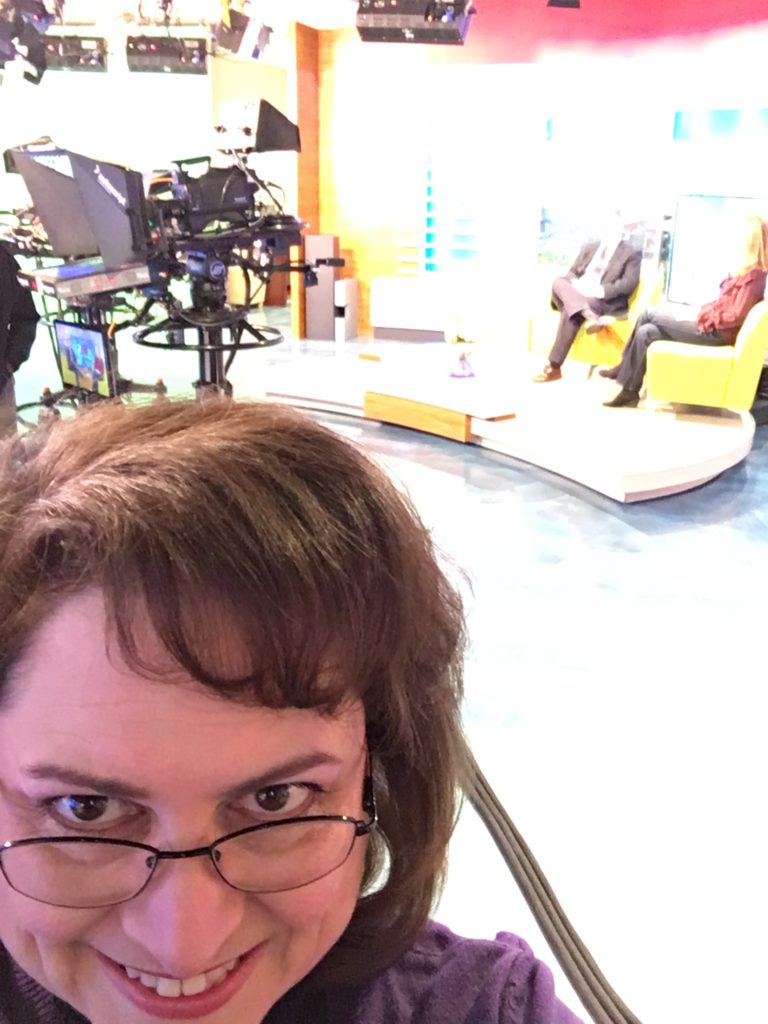
Paper Doll’s NAPO 2016 Conference Recap: The Wisdom Edition
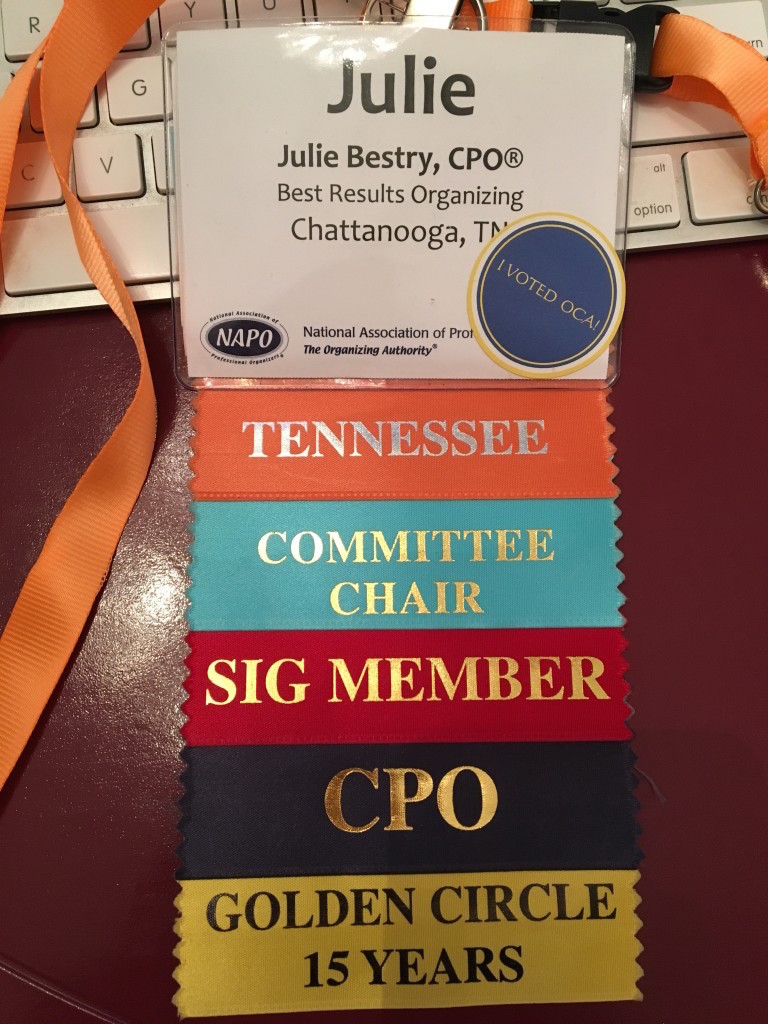
NAPO TIME!
As is the annual tradition at Paper Doll HQ, this is the time of year where we step away from paper-related topics to look at the bigger picture of what’s going on in the organizing world. The Annual Conference and Expo of the National Association of Professional Organizers was held just down the road from me this year, in Atlanta, GA.
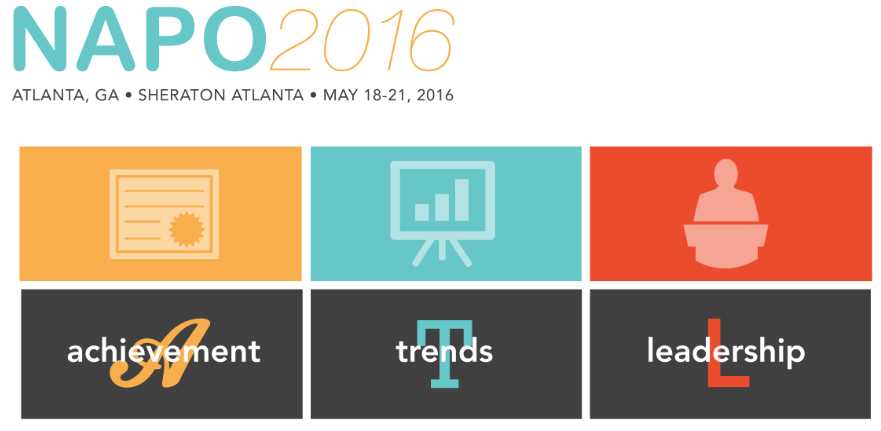 The atmosphere as everyone starts arriving at a NAPO conference is like the first day of summer camp — or a college reunion. We’ve all seen each other on social media, but it’s a delight to view my colleagues when they’re bigger than their one-centimeter high avatars.
The atmosphere as everyone starts arriving at a NAPO conference is like the first day of summer camp — or a college reunion. We’ve all seen each other on social media, but it’s a delight to view my colleagues when they’re bigger than their one-centimeter high avatars.
The first full day is all about preliminary, but important, activities. On Wednesday morning, I attended the Angela F. Wallace Leadership Forum, where we learned techniques and strategies for encouraging and motivating volunteers. In the afternoon, I participated in lively discussions at our meeting of the Board of Certification for Professional Organizers, for which I serve as the Director of Program Development (also known as the Sacred Keeper of All Rules Persnickety) and as the local grammar and spelling cop.
SETTING THE TONE
Our opening keynote speaker, Scott Greenberg, presented The Third Factor: The Mindset for High-Performance Leadership.
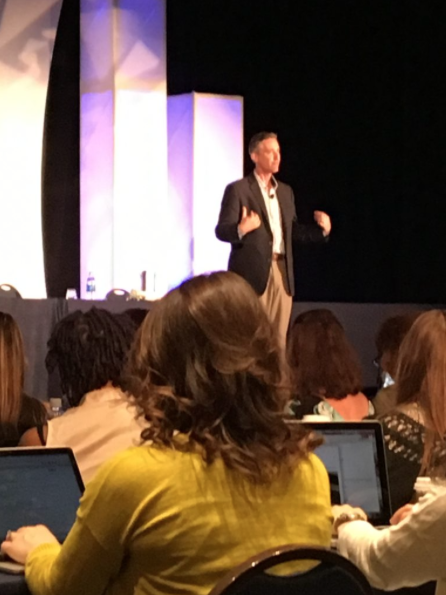
Scott spoke about the three factors that influence success:
- External factors that we can’t personally control, like the economy, what our competition does, the weather, our own DNA,
- Operational factors, over which we have a bit of control, like if we work long enough and hard enough,
- Mindset, or how we think about things, and whether we have a fixed mindset (and believe that we have little-to-no control over our own qualities) vs. a growth mindset, one in which we can improve and grow.
Scott talked about the importance of making interpersonal connections and having gratitude, but my biggest takeaway from his motivational presentation was that it’s not just about the tangible (or even temporal) clutter, but about the “head trash” piled up by our mental hecklers. Scott encouraged us to externalize what these internal hecklers were saying to us so that we could fully appreciate the flaws inherent when we are deprecating ourselves. If you followed any of the tweets from our #NAPO2016 hashtag, you would have seen how much we all embraced Scott’s parting wisdom:
EDUCATIONAL SESSIONS
After the welcome and keynote, we moved on to the meat of our conference sustenance: our concurrent educational sessions, where, over the course of three days, we have the choice of attending one of five classes in each of six concurrent sessions. Somehow, just going to six out of thirty amazing presentations does not seem like enough!
While I work with residential as well as business clients, this year, my focus was on technology and productivity. Courses I took included:
The Art of Tactical Time Management — If you don’t follow the blog and podcast of Mike Vardy, the Productivityist, you’re truly missing out. Perhaps Mike’s presentation resonated with me so much is because it dovetails with what I teach my own clients. For example:
You’ve heard me say this before — if we try to keep things in our heads, or if we leave tangible items out (on our desks, and around our computers, and blocking our doors) to trigger us to think of something, that’s all we do. We think of them, but the energy we waste on remembering something and thinking of it, instead of about it, contextually, is wasted energy. Capture it — write it down on paper or save the thought digitally — and then you can move forward toward your goals.
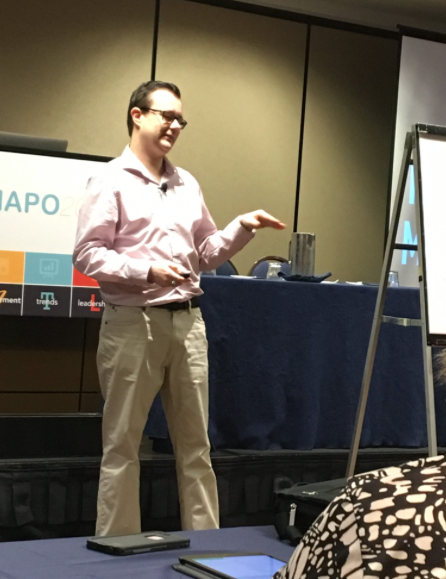
Mike also talked about “time theming” similar to the task-and-time blocking I discussed in my book, 57 Secrets to Organizing Your Small Business (the revised and newly named edition of which will be out later this year). Mike’s time theming (for the year, the month, and the days of the week) is central to his NOW Year Method, about which we learned extensively in the session. I won’t give out those details and spoil Mike’s brilliance — you definitely want to check him out, but I’ll leave you with another of his bon mots.
Other sessions I attended included:
The Paradox of Technology in Business (and Life), in which Nadine Seidman, MSW, MPA, and Nancy Kruschke, CPO®, looked beyond the benefits of technology (communication and collaboration, mobility, and productivity) to the darker costs of technology, including financial (initial and ongoing), physical/health (sleep interruption, neck and back pain), societal (reduced privacy and diminution of etiquette), and psychological (depression, anxiety, and overwhelm). Nadine and Nancy shared great tips for professionals to create “response time policies” for setting expectations for how often, when, and by whom business replies will be made, and encouraged us to unplug ourselves, personally, to recharge. (Just be sure you wait until after you finish reading this post.)
Achieving Balance and Creating Peace with Organizing, where my colleagues Amy Trager, CPO®, and Suzy Margolis Hart used philosophies from the practice of yoga to discuss how we might work better with our organizing and productivity clients. As I once explained on a Smead EZ Grip product testimonial video, Paper Doll has weak, wimpy wrists and appreciates, rather than practices, yoga. However, the messages of this session, from the philosophical — “There is no perfect” — to the practical — how to be non-judgmental, reduce unpleasantness, improve flow, and maintain boundaries — are things we can all use in our work and daily lives.
Down With Digital Clutter, taught by my colleague Pam Holland, seemed to bookend the class on the paradox of technology, and offered up a cornucopia of advice and tools on how to eliminate the clutter that technology builds up. I liked that Pam went against the modern grain (as I do), championing the idea of organizing and building infrastructure for your digital files instead of relying on search technology. My favorite tip, however, and one I intend to keep reminding myself, was that it’s important to remember to empty ALL of the trash. Just as my residential clients are good at remembering to take out their big (usually kitchen) trash on garbage day, while neglecting the tiny bedroom, office, and bathroom trash cans, we all tend to forget that our computers and digital devices have multiple trash cans — not just our desktops, but our emails, our photo collections, and our individual apps, and if they go unemptied, we waste our resources.
Of course, not all of the educational sessions I took were for helping my clients be more productive. The title of my friend and colleague Deb Lee’s Content Marketing: Blogging Tips for Your Small Business practically damns with faint praise what was a 90-minute master class in creating, researching, writing, promoting, and excelling at blogging.
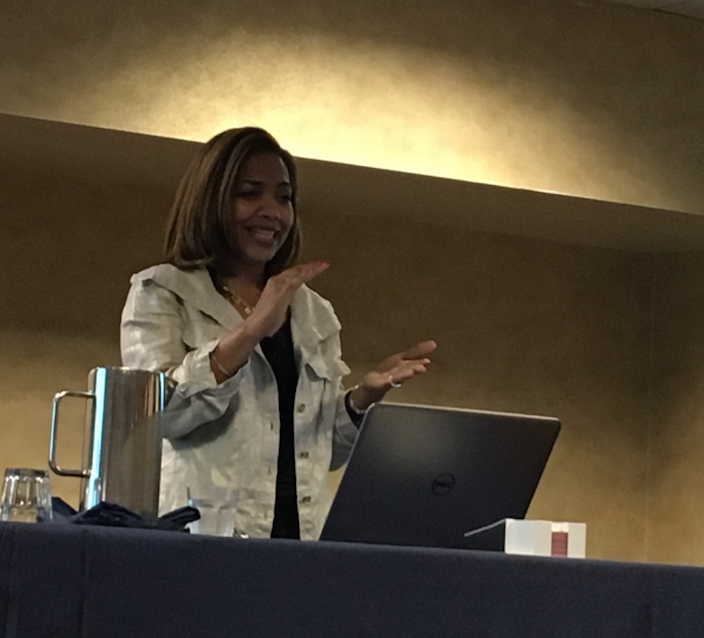
If you are a small business person (or a big business person), there’s nobody better from whom you can learn how to promote your business — so be sure to check out her newly updated D. Allison Lee website to see how her productivity and technology coaching can rock your world. (Nope, this isn’t a paid promotion. Deb is just THAT good that everyone should know about her.)
For those who were interested in other topics, NAPO had them covered with a variety of tracks for classes I’ve not yet mentioned, including:
Business Growth, Marketing, Leadership: Imperfection Rules! Creative Ways to Run Your Business; Coaching Works: Coaching Meets the Organizing World; How to Be an Independent Contractor; Veteran Forum Interactive; How To Keep Your Business from Becoming theIRS! [sic]; What’s Next? Planning an Effective Business Exit Strategy; Strategic Planning to Grow Your Business; Leveraging a Competitive Market: Building Your Personal Brand
Organizing and Productivity: Closets, Pantries, Cabinets, Offices: Beyond the Basics; Photo Organizing Anxiety and How To Overcome It; Transparent Power: Improve Client Outcomes through Direct Communication; Holistic Time Management; Information Afterlife and the Digital Estate Plan
Specific Needs Clients: Still Someone: Organizing Older Adults with Memory Loss; ADHD in the Family: How to Really Help; Play! The Secret Ingredient to ADHD Motivation
Research: Industry Statistics and Trends; Booming Your Baby Boomer Business: Research-based Understanding of this Pivotal Age Group
Special Interest Groups: Moving Made Easy; How Organizers Engage Students; Seven Truths to Becoming a Published Author
Trends, Technology, and Social Media: Power of Email Marketing for Today’s Savvy Organizer; Digital Eyes: Storytelling through Video Marketing; Profit and Value with Online Training
Even if you’re not a professional organizer, I bet you’re envious now!
FOOD, GLORIOUS FOOD (AND KARAOKE)
We professional organizers and productivity specialists take plenty of time to refresh our brains with rest and relaxation — just as we advise our clients. For years, our NAPO meals were almost all taken together, seated at round tables in large ballrooms where the noise and overcrowding made convivial conversation difficult. (It also explains why I had laryngitis by the last day of our conference ever year.)
And let’s be real. Conference food is generally both uninspired and uninspiring. For vegetarians and others with special food requirements, conference dining has also often been a disappointment. (A plate of steamed bok choi does not a meal make!) However, this year, the Atlanta Sheraton did an amazing catering job, and our meals were far superior to anything I’d been served in my last decade and a half of attendance. Still, the hotel could not handle our volume in the traditional way, so we had more buffets and even got to lunch al fresco by the pool.
My favorite addition to our meal experience was this year’s Dine-Around experiment, where attendees could sign up to eat in small groups at any of a number of local restaurants within walking distance from the hotel. I was amused to find that although I’d arrived two days before the official start of conference and was only the sixth person to sign up for a Turkish meal at Atlanta’s Truva, I was the third Julie. Hence, this photo caption:
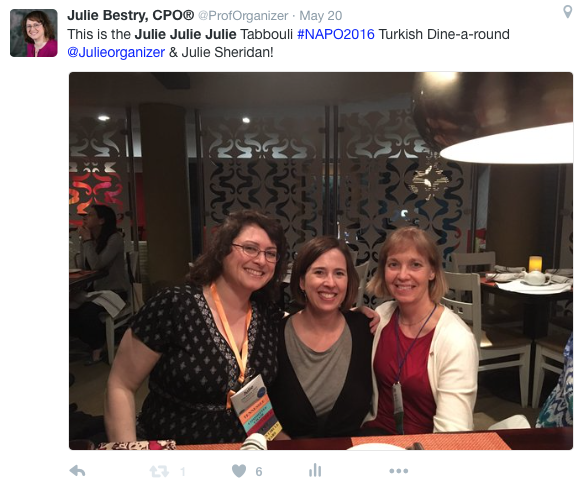
And be assured, lest you imagine that our professional organizing community’s lightheartedness extends only to culinary sustenance, let me disabuse you of that thought. Our NAPO President, Ellen Faye, opened the President’s Reception to all attendees this year for a “Black & White” party that included dancing and karaoke.

So, while we value our education, professionalism, and camaraderie, don’t ever believe the stereotype that professional organizers are stuffy.
In the upcoming NAPO re-cap posts, we’ll be looking at the products and vendors who can help make your life more organized, including the 2016 winners of the NAPO Organizers’ Choice Awards.

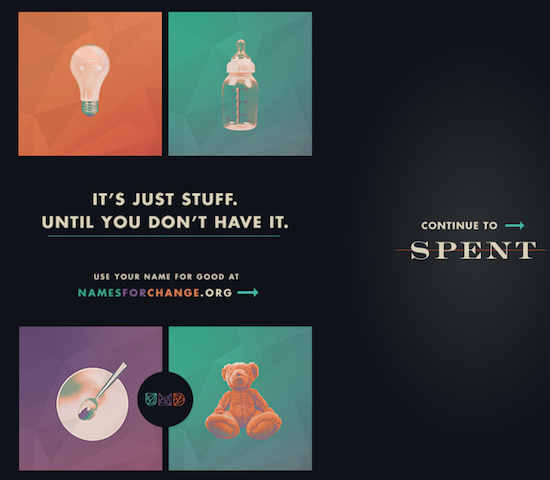




Follow Me